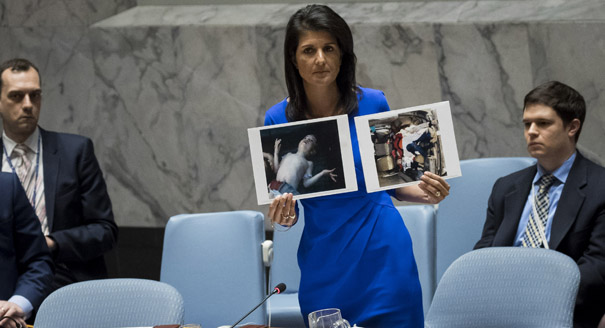If an article in Foreign Policy magazine this week is to be believed, the Trump administration has adopted Barack Obama’s approach to Syria.
Even if many suspected as much, the path to that truth has been a crooked one. Not long before the Syrian regime bombarded Khan Sheikhoun with chemical weapons last April, U.S. Secretary of State Rex Tillerson and Ambassador to the United Nations Nikki Haley sounded cool about the removal of Syrian President Bashar al-Assad. In March, Tillerson remarked, while in Turkey, that Assad’s fate would “be decided by the Syrian people,” a way of saying that what happened to him was not Washington’s business. Soon thereafter, Haley echoed Tillerson by underlining, “our priority is no longer to sit there and focus on getting Assad out.”
Attitudes changed after the outrage in Khan Sheikhoun. Tillerson reversed himself, saying that “steps are underway” in the international community to be rid of Assad. “With the acts that he has taken, it would seem that there would be no role for him to govern the Syrian people,” the secretary added.
Haley also made an about turn, to some degree, when she said, “There is not any sort of option where a political solution is going to happen with Assad at the head of the regime.” Her comments did not spell out a new policy of regime change in Syria, but it did imply that if the U.S. sought a negotiated solution there, then it really had to consider forcing Assad out.
Clear cut? Not quite, if we read Foreign Policy. In an article on July 3, Colum Lynch and Robbie Gramer reported that in a meeting with Antonio Gutteres, the United Nations secretary general, Tillerson told him “that the fate of Syrian leader Bashar Al-Assad now lies in the hands of Russia, and that the Trump administration’s priority is limited to defeating the Islamic State…” The authors cited three diplomatic sources familiar with the exchange for their story.
Tillerson’s about-faces on Assad are certainly disconcerting, but his throwing a Syria solution into Moscow’s lap is hardly new. The Obama administration may not have been so blunt, but its policy toward Syria was also largely premised on allowing the Russians to take the lead there. The previous administration had worked hard to deepen military cooperation with Russia, though the framework it proposed had largely allowed Moscow to pursue its objectives in Syria, which included reinforcing Assad’s regime. The White House’s indifference prompted 51 State Department employees to sign a memo in June 2016 asking the administration to adopt a more aggressive policy against the regime.
Critics of the Trump administration have blamed Tillerson’s latest position on the policy chaos in Washington. That’s too convenient. Instead, his reversals tell us something about how difficult it is to alter a previously set policy. President Donald Trump never viewed Syria as strategically important for the United States, and as a result never sought to push for a new approach to the conflict there.
In recent weeks, as tensions rose around Tanf, near Iraq’s border, where U.S. military personnel are deployed, there was growing alarm that Washington was being sucked into the Syrian conflict. Given Trump’s lack of enthusiasm for a U.S. escalation in Syria, Defense Secretary James Mattis tried to be reassuring in late June when he affirmed, “We just refuse to get drawn into the Syrian civil war.” Tillerson’s remarks to Gutteres were merely a variation on this theme.
However, one can only marvel at how the Trump administration appears not to recognize the interrelated nature of its stated objectives in Syria, particularly with regard to Iran. Unlike the Obama administration, which considered a nuclear accord with Tehran a strategic priority, Trump has vowed to get tough with the Islamic Republic. For a moment last May it appeared the U.S. was as good as its word, seeking to prevent Iran’s control of the Syrian-Iraqi border. It seemed to want to deny Tehran a land passage that might be used to send major reinforcements into Syria and Lebanon in the event of a war with Israel. However, Tillerson’s latest statements to Gutteres cast doubt on such an interpretation.
No less important is that the Trump administration, while it has voiced support for the Geneva process on Syria, has stood by as Geneva has been gradually displaced by the Russian-Iranian-Turkish-sponsored Astana negotiations. By effectively abandoning Geneva, with its condition that a political transition away from Assad must take place, the U.S. has allowed Russia and Iran to define the political endgame in Syria to their own advantage. Given that Iran’s veto power over a solution is significant, it’s not clear how subcontracting Syria’s future to Russia will advance U.S. interests or fulfill Trump’s desire to counter Iranian influence.
Basically, Trump, like Obama, has reduced his Syria policy to one endeavor: destroying the so-called Islamic State. Those who say this shows policy confusion in Washington are wrong. Trump knows exactly what he wants in Syria—to keep the country at arm’s length. Precisely what Obama wanted.






